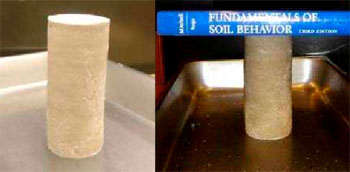Strengthening the soil will decrease earthquake damage
An interdisciplinary group of researchers at Purdue University have found that adding small quantities of bentonite to fine sands reduces the risk of liquefaction. This NSF collaborative research project includes Purdue Civil Engineering Professors Antonio Bobet, Vincent P. Drnevich and Marika C. Santagata, Professor Cliff T. Johnston, Agronomy, and Professor Alexander Wei, Chemistry.

Clean Sand Specimens treated with Bentonite. The wet sand stands under its own weight (left photograph) and can even carry loads (right photograph).
The work, sponsored by NSF, and led by Purdue engineers, Professors Antonio Bobet, Vincent P. Drnevich and Marika C. Santagata, Civil Engineering, Professor Cliff T. Johnston, Agronomy, and Professor Alexander Wei, Chemistry, have shown that by introducing 3% to 5% bentonite (by dry mass of soil), into the sand pore space liquefaction does not occur, or the number of cycles needed to produce liquefaction is measured in the hundreds. Given the duration of most earthquakes, this implies that the sand would not liquefy. Even when liquefaction occurs, the soil does not completely lose its shear strength. A residual strength remains, which is interpreted as the result of the changes in the rheological properties of the pore fluid caused by the bentonite. As excess pore pressures dissipate after the liquefaction event, the soil “heals” itself and shows behavior under cyclic loading similar to the pre-liquefied soil. Results obtained in resonant column tests indicate that the presence of bentonite increases the linear threshold of the treated sand and thus delays to higher strains the development of excess pore pressures produced by repeated loading. Since the amounts of bentonite added are small the static strength and stiffness of the soil are not much affected.
Because bentonite particles are electrically charged, particle interactions can be modified chemically. The researchers have found that by adding 0.1% to 1%, by clay mass, of pyrophosphate, the viscosity of concentrated bentonite dispersions drops to a value very close to that of water, allowing delivery of the bentonite into a sand matrix through permeation. Over time, the bentonite slurry recovers its thixotropic properties.
This method has significant practical applications in that a new technology could be developed to mitigate liquefaction effects at earthquake-vulnerable sites with minimal disturbance to the ground. The treatment will be effective during an earthquake while not affecting the ability of the soil to carry static loads.
